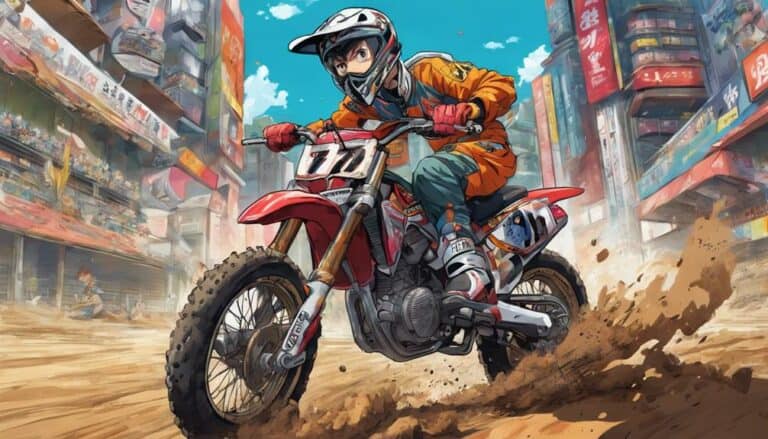If your dirt bike stalls when you pull in the clutch, you might have heard about the impact of low engine idle speed on this issue.
However, there could be more to the story than just idle speed.
Understanding how various factors like fuel mixture, clutch cable adjustments, and other mechanical components play a role in stalling can provide a thorough solution to your problem.
Stay tuned to uncover the intricate details behind why your dirt bike stalls when you engage the clutch.
Key Takeaways
- Check clutch adjustment and cable for proper tension.
- Ensure idle speed is within manufacturer’s range.
- Maintain balanced fuel mixture for optimal performance.
- Regularly inspect and lubricate clutch cable for smooth operation.
Common Reasons for Stalling When Clutching
When diagnosing why your dirt bike stalls when you pull in the clutch, it’s essential to contemplate several common culprits that could be causing this issue. One possible reason for the stalling could be an incorrectly adjusted clutch cable. If the clutch cable is too loose or too tight, it can lead to improper disengagement of the clutch, resulting in the bike stalling when the clutch is pulled in.
Another factor to consider is the condition of the clutch plates. Dirty or worn clutch plates may prevent smooth engagement and disengagement of the clutch, causing stalling.
Additionally, issues with the clutch basket can also contribute to stalling. If the clutch basket has grooves or shows signs of wear, it can impact the overall performance of the clutch system, leading to stalling when the clutch is engaged.
Additionally, improper throttle adjustment or idle speed can play a role in stalling when pulling in the clutch. Ensuring that the throttle is properly adjusted and the idle speed is set correctly can help prevent stalling issues.
Proper Clutch Adjustment Techniques
To guarantee your dirt bike operates smoothly and efficiently, mastering proper clutch adjustment techniques is key. Proper clutch adjustment ensures that the clutch engages smoothly, preventing premature wear on clutch components.
Begin by checking the free play in the clutch lever, as having adequate free play is essential for the best performance. Adjust the clutch cable tension according to the manufacturer’s specifications to make sure the clutch functions correctly.
A well-adjusted clutch not only helps prevent stalling but also enhances shifting precision, making your rides more enjoyable. It’s essential to find the right balance in clutch adjustment to achieve the best performance from your dirt bike.
Impact of Low Engine Idle Speed
Low engine idle speed can greatly impact a dirt bike’s performance, potentially leading to stalling when the clutch is engaged. When the idle speed is set lower than recommended, the engine may not generate enough power to sustain itself when the clutch is disengaged, such as when coming to a stop.
To guarantee smooth clutch engagement and prevent stalling, it’s important to have the engine running at the correct idle speed. Adjusting the idle speed within the manufacturer’s specified range is essential for preventing stalling issues when pulling in the clutch.
By regularly checking and fine-tuning the engine idle speed, you can maintain the best performance and avoid stalling occurrences. Remember, a well-adjusted idle speed plays an essential role in the seamless operation of your dirt bike’s clutch system.
Keep your engine idle speed at the right setting to enjoy a smooth and uninterrupted ride without the frustration of unexpected stalling when engaging the clutch.
The Role of Fuel Mixture in Stalling
Improper fuel mixture greatly impacts a dirt bike’s clutch performance, potentially leading to stalling occurrences. When the fuel mixture is vital, stalling can occur during clutch engagement due to insufficient lubrication and cooling.
Conversely, a rich fuel mixture can also contribute to stalling issues when the clutch is disengaged, causing incomplete combustion and decreased engine efficiency. The imbalanced fuel mixture not only affects engine performance but also influences the responsiveness of the clutch operation.
To prevent stalling related to fuel mixture issues, it’s key to verify the correct adjustment of the fuel mixture on your dirt bike. By maintaining the proper fuel mixture, you can optimize engine function, enhance clutch engagement, and decrease the likelihood of stalling when manipulating the clutch.
Evaluating the Clutch Cable for Issues
Inspect the clutch cable on your dirt bike for proper routing, alignment, and any signs of wear that could impact its functionality.
- Confirm the clutch cable is routed correctly to avoid binding or kinking, which can lead to issues with clutch engagement and disengagement.
- Check for any fraying, wear, or damage on the clutch cable, as these signs can affect its performance and durability.
- Verify that the clutch cable has the appropriate amount of free play as per the manufacturer’s specifications to guarantee smooth operation.
Regularly lubricating the clutch cable is important to maintain its smooth functioning and prevent sticking. Additionally, adjusting the clutch cable tension when necessary is essential to make sure that the clutch operates seamlessly.
Conclusion
Now that you’ve learned about the common reasons for your dirt bike stalling when you pull in the clutch, make sure to check throttle body synchronization, adjust valves correctly, and verify clutch cable adjustment.
Think of your bike’s maintenance like tuning a finely crafted instrument – with precision and care, you can guarantee smooth performance on the trails.
Keep your bike running smoothly like a well-oiled machine, and enjoy the ride!

